9 /10 1 Votes9
Director(s) Andrew Prokhorov Artist(s) Andrey Tkachenko | 9/10 Steam Designer(s) Viacheslav Aristov Initial release date 16 March 2010 | |||||||||||||||||||||||||||||||||
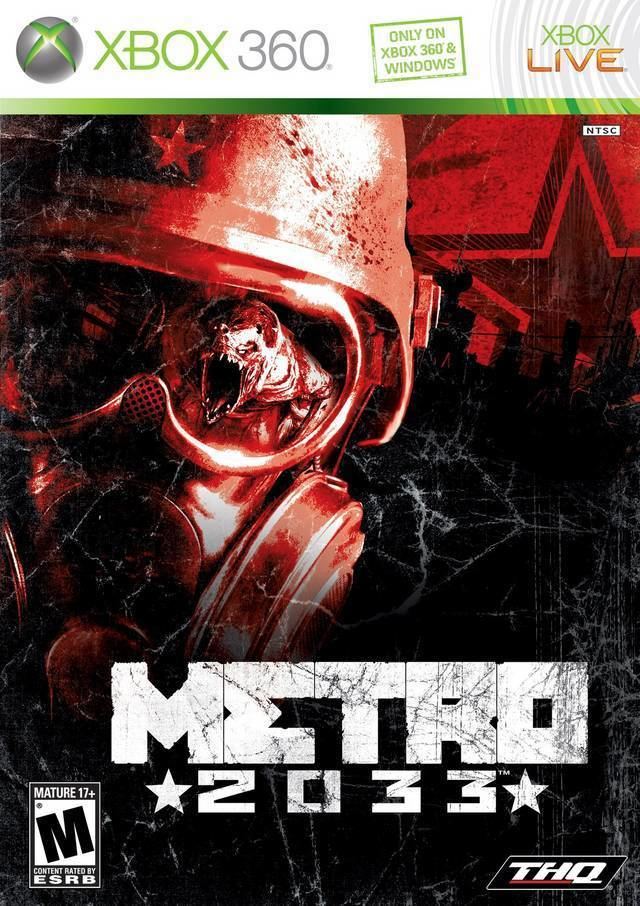 | ||||||||||||||||||||||||||||||||||
Programmer(s) Oles ShyshkovstovAlexander MaximchukAlexei Buinitskiy Writer(s) Dmitry GlukhovskyAndrew ProkhorovViacheslav Aristov Composer(s) Alexey OmelchukGeorgiy Beloglazov Genres First-person shooter, Survival horror Nominations Interactive Achievement Award for Outstanding Achievement in Story Similar Deep Silver games, First-person shooter games | ||||||||||||||||||||||||||||||||||
Metro 2033 is a first-person shooter survival horror video game developed by 4A Games and published by THQ. It was released in 2010 for the Xbox 360 and Microsoft Windows. The story is based on Dmitry Glukhovsky's novel of the same name, and is set in the ruins of Moscow following a nuclear war, where the survivors are forced to live in underground metro tunnels. Players control Artyom, a man who must defeat an evil mutant race known as the Dark Ones.
Contents
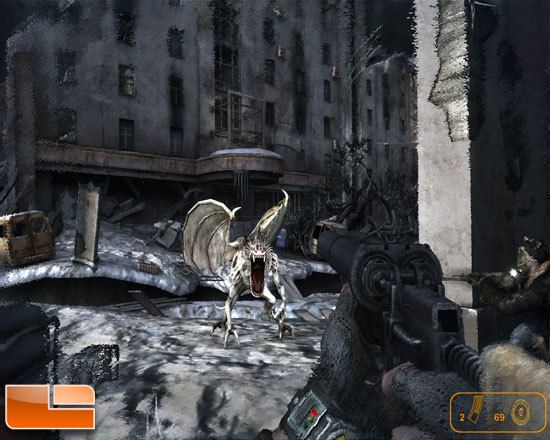
Metro 2033 is played from a first-person perspective. Players encounter human and mutant enemies, who can be killed with a variety of firearms; alternatively, players can employ stealth to evade or silently kill enemies. Ammunition and other necessary items must be either scavenged from the bodies of dead enemies, or purchased from vendors. Some areas of the metro tunnels, including the entirety of the Earth's surface, are covered in radiation, and the player must wear a gas mask to explore these areas. If the gas mask is worn while in combat, it may be damaged, and the player must quickly find a replacement before they die.
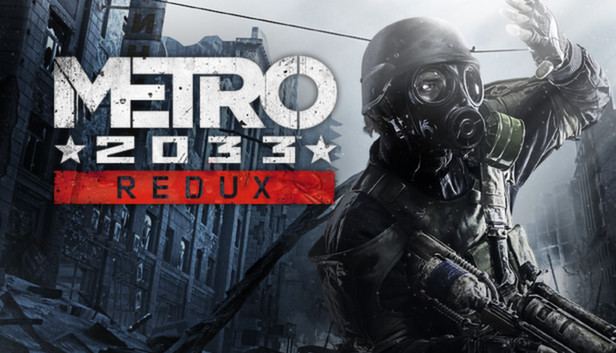
Metro 2033 received positive reviews from critics: it was praised for its horror elements, detailed environments and appealing plot, but it was criticized for its buggy artificial intelligence and its many graphical issues.
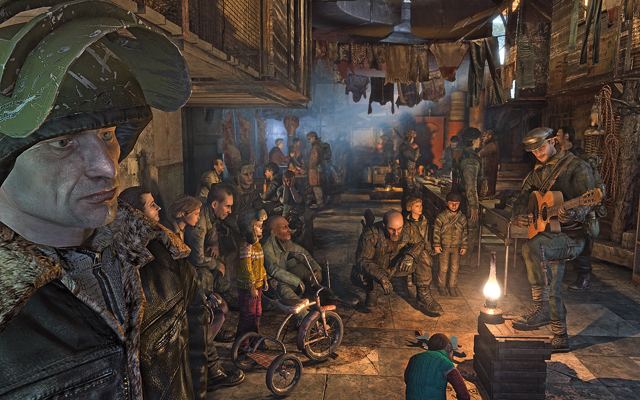
A sequel, Metro: Last Light, was released in May 2013. On August 26, 2014, a compilation of both titles was released for Microsoft Windows, PlayStation 4, and Xbox One. On PlayStation 4 and Xbox One, this remake was entitled Metro Redux. On Microsoft Windows, OS X, Linux, and SteamOS, a release entitled as Metro Redux Bundle includes both this game and Metro: Last Light Redux.
Gameplay
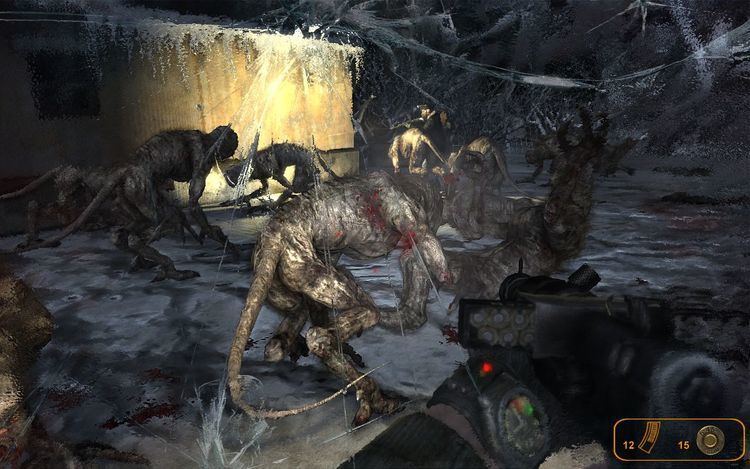
Metro 2033 is a first-person shooter video game. It is predominately set within the tunnels of the Moscow Metro system, though some sections take place on the surface, in the ruins of Moscow. The story is told through a linear single-player campaign, and important plot moments are shown during cutscenes.

The player will encounter several human and mutant enemies, who can be killed with a variety of firearms. The game features traditional guns like revolvers and shotguns, as well as more inventive weapons like a pneumatic crossbow. In firefights, human enemies will take cover and flank the player, while mutant enemies will stay in the open and try to bite them. Alternatively, the player can employ stealth to evade their enemies or kill them silently. This can be achieved by using a throwing knife to kill an enemy from afar, or shoot an enemy with a suppressed weapon. If the player is shot or bitten while in combat, they can either wait for their health to recharge, or use a med-kit to heal themselves immediately.
The player will often have little ammunition, and must scavenge for bullets and other useful items from the bodies of dead enemies or from caches. 5.45×39mm ammunition (referred to in the game as "military grade ammunition") can also be found, which serves as the currency within the tunnels. The player can either spend military grade ammunition on new weapons, or use it in firefights, which will inflict more damage on enemies than normal bullets. As most of the tunnels feature little to no light, the player can use a flashlight to explore dark areas. In addition to the dimly lit tunnels, some areas, including the entire surface, are covered in radiation, and require the use of a gas mask. If the player engages in combat while wearing a gas mask, it may become damaged and crack, forcing the player to find an unused gas mask.
Throughout the game, there are certain moral choices that can be made. If the player is compassionate to the people living in the tunnels, such as giving the homeless some military grade ammunition, they may be able to watch a different cutscene at the end of the game. These moral choices are never explicitly mentioned, and it is possible to play through the game without knowing of their presence.
Plot
In 2013, a nuclear war occurred. Russia was targeted with atomic bombs, causing severe radiation across Moscow. This forced the survivors to live underground in the metro stations away from the deadly effects of radiation. Many animals were heavily mutated into aggressive beasts, which made travel dangerous.
Twenty years later in 2033, the northern Metro station of VDNKh (known in-game as "Exhibition") is under attack by a group of mysterious creatures referred to as the Dark Ones. Artyom (Russian: Артём), a 20-year-old male survivor born before the bombs fell, is persuaded to leave his home there and seek help from the rest of the Metro by Hunter, an elite soldier of the Polis Rangers. Hunter gives Artyom his dog tags and tells him to present these to see if the rest of the Rangers will help his station.
Artyom must travel through territory occupied by the Stalinist 'Red Line' and a Fourth Reich, and infested with mutants as well as the much changed surface of Moscow. Once in Polis, he meets with a Ranger named Miller, who agrees to help him. Miller knows of a missile silo known as D6 that has the firepower necessary to destroy the Dark Ones. Artyom, Miller, and several other Rangers reactivate the command center, and Artyom installs a laser guidance system on a nearby radio tower. After the laser system is installed, Artyom experiences a vivid hallucination induced by a Dark One.
After the hallucination, two endings are possible depending on choices the player makes throughout the game. In the canonical ending, Artyom allows the missiles to fire, destroying the Dark Ones; only to realize later that they sought peace and the deaths by them were accidental. The alternate ending gives Artyom the choice to destroy the laser guidance device, citing a last-minute realization that the Dark Ones were actually attempting to make peaceful contact through the hallucinations. This ending is only available by performing various positive acts throughout the game, such as helping out fellow humans and not automatically fleeing the Dark Ones in various hallucinations.
Development
4A Games was founded by Oles' Shiskovtsov and Aleksandr Maksimchuk, former programmers for GSC Game World who left about a year before the release of S.T.A.L.K.E.R.: Shadow of Chernobyl. Shiskovtsov and Maksimchuk had worked on the development of X-Ray engine used in the S.T.A.L.K.E.R. series. In March 2006, 4A Games announced a partnership with Glukhovsky to collaborate on the game. The game was announced at the 2009 Games Convention in Leipzig; along with an official trailer.
The game utilizes multi-platform 4A Engine, running on Xbox 360 and Microsoft Windows. There is some contention regarding whether the engine is based on the pre-release X-Ray engine (as claimed by Sergiy Grygorovych, the founder of GSC Game World, as well as users who have seen the 4A Engine SDK screenshots, citing visual similarities, shared resources, and technical evaluation of the pre-release 4A Engine demo conducted at the request of GSC Game World), or whether the engine is an original development (as claimed by 4A Games and Oles' Shiskovtsov in particular, who claims it would have been impractical to retrofit the X-ray engine with console support). 4A Engine features Nvidia PhysX support, enhanced AI, and a console SDK for Xbox 360. The PC version includes exclusive features such as DirectX 11 support and has been described as "a love letter to PC gamers" because of the developers' choice "to make the PC version [especially] phenomenal".
A PlayStation 3 version was planned, but ultimately cancelled. On February 19, THQ and 4A Games announced the game features Steamworks software and DRM. This gives Metro 2033 achievements, Steam support for in-game downloadable content and auto-updating.
Release
A Collector's Edition of the game was released in Russia – it contained the game itself in special packaging, a game guide, a map of the post-apocalyptic subway of Moscow and a unique watch with the game's logo on it. An even larger collector's edition was released in Poland; it contained: the game itself in special packaging, a Polish translation of the novel Metro 2033, instructions for the game, an army container and a gas mask (with filters and a military bag included). A special edition was also released in Germany – more similar in size to the Russian collector's edition and smaller than the Polish one, it contained: the game itself in a special edition box, a hardback novel (A5 sized) titled "Davor und Danach" (Before and After), a fully working replica of the watch that Artyom uses in the game, a bear-shaped key ring with one of Hunter's dog tags on it and a download code for the Heavy Automatic Shotgun.
In February 2014, the Xbox 360 version of 2033 was included in Microsoft's "Games with Gold" program exclusively for German subscribers. This served as a replacement for Dead Island, the game offered in other territories, as it is unavailable for purchase in Germany. On May 22, 2014, a Redux version of the game was announced. It uses the latest version of the 4A Engine bringing the graphical and gameplay changes from Last Light to 2033. It was released on August 26, 2014 in North America and August 29, 2014 in Europe for the PC, PlayStation 4, and Xbox One. A compilation package, titled Metro Redux, was released at the same time which includes both games. A demo of the Redux version, which allows players to play through the first one-third of the game, was released for the PlayStation 4 and Xbox One on June 2, 2015.
In August 2015, the Xbox 360 version of 2033 was included in Microsoft's "Games with Gold" program for most Xbox Live regions.
Reception
Metro 2033 received favorable reviews from critics, scoring 81/100 and 77/100 on Metacritic for the PC and Xbox 360 versions respectively. Game Informer praised it, giving it 9 out of 10. GameZone's Dakota Grabowski gave the game an 8 out of 10, saying, "The single-player affair is worthy of every FPS fanatics' time since the 4A Games and THQ were able to put forth a wonderful tale that deserved telling. The world is engrossing as it invites players for multiple trips with the sheer amount of detail 4A Games spent implementing into the environments. Metro 2033 is as pure as they come in the genre and I gladly welcome any sequel that may reach fruition."
Good Game gave the game an 8.5 out of 10 praising the RPG and survival horror elements which add richness to the gameplay as well saying the HUD-less design was a choice which suits this particular game. Overall they said "I'm a big Fallout 3 fan and I was worried this would try to be something similar and fail dismally. But it's more FPS than RPG, so I think it manages to dodge a direct comparison. They've just worked really hard to bring RPG narrative and decisions into the action, and it works."
X-Play gave Metro 2033 a 3 out of 5. The reviewer approved of the game's atmosphere and attention to detail, and stated that the game had some truly scary moments. The reviewer also stated that the developers "didn't do enough with the creepy atmosphere", that the game had some almost truly frightening moments, but "never truly commits to scaring the audience". The reviewer said that the mapping of the buttons on the controller for the Xbox 360 can be "less than optimal", but the problem does not apply to PC users. In the conclusion, the reviewer said that the game was "over all a respectable effort, provided you don't expect the same level of depth found in, let's say Fallout 3."
GameSpot gave Metro 2033 7.5 out of 10 for the Xbox 360 version and 8 out of 10 for the PC version, praising the atmosphere but noting problems with the artificial intelligence and animations. IGN gave the game a lower rating of 6.9 out of 10 (identical for Xbox 360 and PC versions), citing the frame rate, bugs, and disappointing graphics as issues. Ben Croshaw of Zero Punctuation stated that Metro 2033 was "basically all right".
Sequel
Metro: Last Light was released on May 14, 2013 in North America and May 17, 2013 in Europe, Australia, New Zealand and Russia. Even though it acts as a sequel to the original game, it does not follow any direct storylines from the book Metro 2034. An improved version called Redux, with all downloadable content was released on August 26, 2014 in North America and August 29, 2014 in Europe for the PC, PlayStation 4, and Xbox One. A compilation package, titled Metro Redux, was released at the same time which includes both Last Light and Metro 2033.
